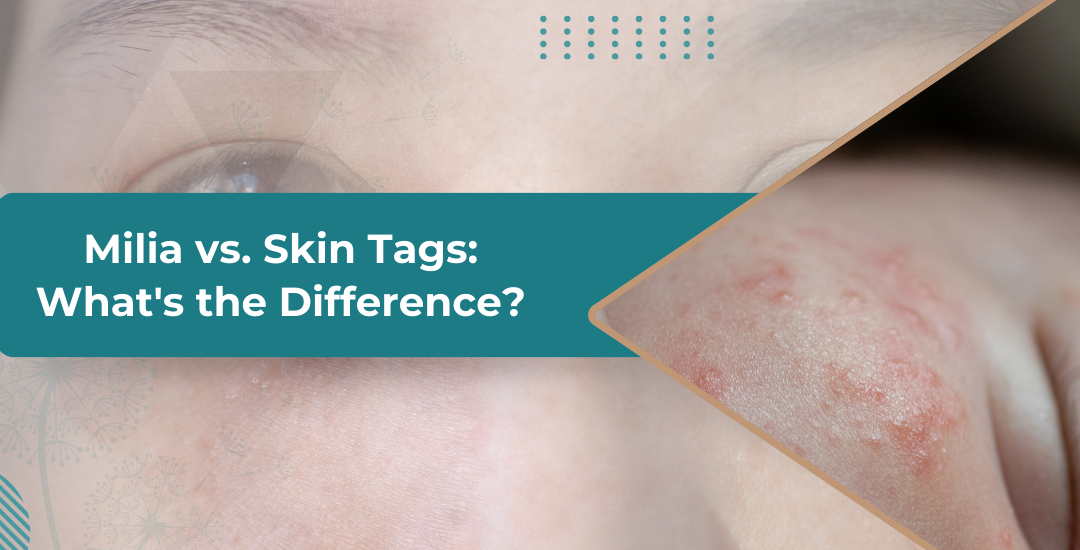Noticing tiny bumps or fleshy growths on your skin can be concerning, especially when they appear unexpectedly. Many people mistake milia for skin tags or vice versa, leading to confusion about how to treat them. The good news is that both conditions are harmless, though professional care may be required for removal.
“Milia and skin tags may look similar, but their causes and treatments differ. Understanding their differences can help you choose the right approach,”
says Dr. Swetha P., a highly regarded dermatologist in Indiranagar, Bangalore.
At Dr. Swetha’s Cosmoderm Centre, she offers cutting-edge treatments for Milia, skin tags, and other dermatological concerns, focusing on individualized solutions for her patients.
Have you noticed small, stubborn white bumps on your face? These may not be acne but something entirely different.
Milia: Tiny White Bumps – What Are They?

Milia are small, white or yellowish cysts that form when keratin is trapped under the skin. These tiny bumps are often mistaken for whiteheads, but they do not contain pus and cannot be popped like acne. Unlike skin tags, Milia are firm and do not dangle from the skin.
Causes of Milia
- Blocked sweat ducts or hair follicles
- Skin trauma or burns
- Use of heavy skincare products
- Genetic predisposition
Where Milia Typically Appear
Milia commonly appears on the face, especially around the eyes, cheeks, and forehead. They can also develop on the chest and arms, particularly in newborns.
Duration:Symptoms usually resolve within 6 to 8 weeks without treatment.
Worried about persistent white bumps? Seek professional guidance for the most effective treatments. Book an appointment today!
Skin Tags: Those Fleshy Growths
Skin tags are soft, flesh-coloured growths that hang from the skin. Unlike milia, they are not cystic but relatively small pieces of excess skin connected by a thin stalk. While harmless, they can be annoying if they rub against clothing or jewellery.
Skin tags tend to form in skin folds where friction occurs. They are more common in adults, especially those who are overweight or have diabetes.

What is the Main Cause of Skin Tags?
- Friction from skin rubbing against itself
- Hormonal changes, especially during pregnancy
- Insulin resistance and diabetes
- Genetic predisposition
Where Skin Tags Typically Appear
- Neck
- Underarms
- Eyelids
- Groin
- Under the breasts
Annoyed by small, hanging skin growths? Learn safe and effective removal options from a skincare expert. Schedule a consultation today!
Confused about whether you have Milia or skin tags? Knowing their differences can help you choose the right treatment.
Milia vs. Skin Tags: Key Differences Explained
Milia and skin tags may seem similar at first glance, but their distinct characteristics set them apart. Below is a detailed comparison to help you identify them accurately:
|
Feature
|
Milia |
Skin Tags |
|
Appearance |
Tiny, white or yellow cysts |
Soft, fleshy growths that dangle from the skin
|
|
Texture |
Firm and do not move |
Soft and easily movable
|
|
Causes |
Trapped keratin under the skin |
Friction, hormonal changes, and genetic factors
|
|
Common Areas |
Face, particularly around the eyes and cheeks |
Neck, underarms, eyelids, groin, and beneath the breasts
|
|
Treatment |
Exfoliation, extraction, or laser treatments |
Cryotherapy, electrocautery, or surgical excision |
Frustrated by stubborn Milia that won’t go away? There are effective treatments available to help you clear them.
How to Get Rid of Milia
Milia removal requires a combination of professional treatments and preventive skin care. Since Milia does not go away on their own, especially in adults, dermatological intervention is often necessary.

- Extraction– A dermatologist carefully removes Milia using a sterile needle or a small incision, ensuring minimal scarring.
- Chemical Peels– AHA or BHA peels help exfoliate the top layer of the skin, gradually reducing the appearance of Milia.
- Laser Therapy– Non-invasive laser treatments target and break down Milia without harming the surrounding skin.
- Microdermabrasion– A gentle
exfoliation method that removes dead skin cells and prevents keratin buildup.
- Topical Retinoids– Prescription-strength retinoids accelerate skin turnover, reducing existing Milia and preventing new ones from forming.
Preventive Skincare for Milia
- Use gentle exfoliants with AHA or BHA to prevent clogged pores.
- Choose non-comedogenic skincare products to avoid trapping keratin under the skin.
- Apply lightweight moisturizers instead of heavy creams that can contribute to pore congestion.
- Protect your skin with sunscreen to prevent sun damage, which can worsen Milia formation.
Looking for ways to remove skin tags safely? Let’s explore several simple and effective treatment options.
How to Get Rid of Skin Tags
Skin tags can be safely removed using professional treatments that minimize discomfort and scarring.

- Cryotherapy– Liquid nitrogen is applied to freeze the skin tag, causing it to fall off within days.
- Electrocautery– The tag is burned off using a controlled electric current, sealing the skin to prevent bleeding.
- Surgical Removal– A dermatologist carefully cuts off the skin tag using sterile surgical tools, often under local anesthesia.
- Ligation– A small surgical thread is tied around the base of the skin tag, cutting off the blood supply until it naturally detaches.
Preventive Skincare for Skin Tags
- Maintain a healthy weight to reduce friction in skin folds.
- Wear loose-fitting clothing to prevent unnecessary rubbing.
- Keep skin clean and dry, especially in areas prone to friction.
- Use gentle skincare products to avoid irritation and inflammation.
Not sure when to seek medical help for your skin condition? Some warning signs indicate it’s time to consult a professional.
When to See a Doctor
- If Milia or skin tags change in size, shape, colour, or texture.
- If they become painful, inflamed, irritated, or start bleeding.
- If you notice rapid growth or an unusual appearance.
- If you have multiple skin tags or Milia that cause discomfort or affect your confidence.

Conclusion
Milia and skin tags are common and harmless skin conditions that can cause cosmetic concerns. While Milia requires exfoliation and professional extraction, skin tags can be easily removed through simple medical procedures. Whether dealing with stubborn Milia or annoying skin tags, seeking professional care from a seasoned skin specialist in Indiranagar, Bangalore, like Dr. Swetha P, ensures safe and effective treatment.
Concerned about unusual bumps on your skin?Consult a specialist for proper diagnosis and solutions to achieve a clearer complexion.
Frequently asked question.
Are milia the same as skin tags?
Milia and skin tags are different skin conditions. Milia are tiny cysts filled with keratin, while skin tags are soft growths that hang from the skin. They have different causes and treatment methods.
Is it safe to remove Milia?
Milia removal is safe when done by a professional using sterile techniques. Avoid attempting to remove them at home to prevent scarring or infection.
Do Milia grow bigger?
Milia do not grow bigger but may persist if not treated and multiply if the underlying cause is not addressed.
Why am I growing skin tags?
Skin tags often develop due to friction, hormonal changes, or genetic factors. They are common in areas where skin rubs against itself, such as the neck and underarms.
Is it OK to pick skin tags?
No, picking or cutting skin tags at home can cause bleeding, infection, and irritation. Professional removal is the safest option.
Do skin tags turn into cancer?
No, skin tags are benign and do not turn into cancer. However, any unusual skin growth should be evaluated by a professional.
Do skin tags grow back after removal?
Once removed, a skin tag does not grow back. However, new skin tags may develop in other areas over time.
Reference links:
https://my.clevelandclinic.org/health/diseases/17868-milia
https://www.medicalnewstoday.com/articles/67317
Disclaimer: This page is for informational purposes and not for promotional use.


 exfoliation method that removes dead skin cells and prevents keratin buildup.
exfoliation method that removes dead skin cells and prevents keratin buildup.